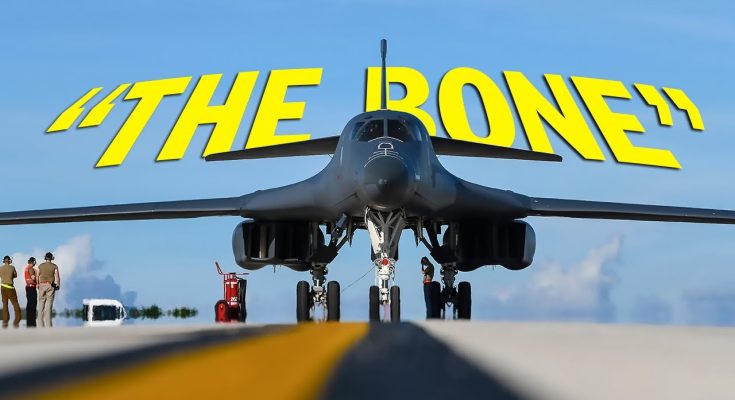US New B-1B Lancer After Upgrade Shocked The World
The B-1B Lancer, an iconic long-range strategic bomber of the U.S. Air Force, has undergone an extraordinary upgrade that has left military analysts and enthusiasts around the world stunned. Known for its high-speed, low-level penetration capabilities and versatile payload, the B-1B has long been a cornerstone of the U.S. bomber fleet. However, recent upgrades to this already formidable aircraft have elevated it to new heights, enhancing its combat potential and redefining its role in modern warfare.
A Legacy of Power and Speed
The B-1B Lancer, originally introduced in the 1980s, was designed to replace the aging B-52 Stratofortress and to offer a faster, more flexible strategic bomber. Unlike its predecessors, the B-1B features variable-sweep wings, which allow it to operate efficiently at both subsonic and supersonic speeds. The aircraft’s design allows it to carry out a wide range of missions, from conventional bombing to deep strike operations, and it can carry a diverse array of munitions, including precision-guided bombs, cruise missiles, and nuclear payloads.
While the B-1B has been a vital part of the U.S. Air Force’s arsenal, it had begun to show signs of aging over the years. Despite undergoing some upgrades in the past, the aircraft needed modernization to maintain its relevance in an increasingly complex and high-tech battlefield.
The Upgrade: A New Era of Capability
The most recent upgrade to the B-1B Lancer, known as the “B-1B Upgrade Program,” is nothing short of revolutionary. The program, initiated in the mid-2010s, sought to enhance the bomber’s survivability, extend its operational life, and improve its effectiveness in modern warfare. These upgrades were designed to address the rapidly evolving nature of air combat and ensure the B-1B remains a powerful asset in the U.S. Air Force’s strategic capabilities.
One of the most shocking aspects of the upgrade is the addition of cutting-edge avionics, radar, and communications systems. The B-1B has been outfitted with advanced electronic warfare capabilities, improved radar systems, and a modernized cockpit. These updates allow the bomber to operate in contested environments with a higher degree of survivability, ensuring it can penetrate increasingly sophisticated enemy air defenses. The new systems also allow for greater interoperability with other U.S. and allied aircraft, making the B-1B more versatile in joint operations.
Additionally, the upgrade program includes enhanced weapons systems, including the ability to carry more advanced munitions. The B-1B is now capable of launching a broader range of precision-guided weapons and long-range missiles, improving its strike capabilities. The aircraft has also been updated to carry hypersonic weapons, which are becoming increasingly important in modern warfare due to their speed and difficulty to intercept.
The Impact on Global Power Dynamics
The enhanced capabilities of the B-1B Lancer have shocked the world, particularly because the upgrade has revived an aircraft that was initially thought to be approaching the end of its service life. With the new avionics, weapons systems, and stealth enhancements, the B-1B can now challenge the most advanced air defenses and strike targets with greater precision and speed than ever before. This has significantly bolstered the U.S. Air Force’s strategic deterrence and strike capabilities.
Moreover, the B-1B’s ability to carry hypersonic weapons positions it as a key player in the emerging field of hypersonic warfare. The speed and range of hypersonic weapons make them difficult to counter, and the B-1B’s integration of these systems allows the U.S. to maintain a technological edge over its adversaries.
A New Role for the B-1B
The B-1B Lancer is no longer just a strategic bomber; it has evolved into a multi-role, high-tech weapon system that can support a variety of missions. Its ability to deliver a wide range of munitions, including conventional and nuclear payloads, combined with its enhanced survivability and precision, ensures that the B-1B remains a vital component of U.S. military operations. It can conduct everything from precision strikes to tactical support and strategic deterrence, all while maintaining its ability to operate in contested airspaces.
The upgraded B-1B Lancer’s shockwaves have been felt globally, with both allies and adversaries taking note of the aircraft’s newfound capabilities. The U.S. Air Force has confirmed that the B-1B will remain a crucial part of its bomber fleet for many years to come, with its upgraded systems ensuring that it continues to dominate the skies in the face of evolving threats.
Conclusion
The upgraded B-1B Lancer has proven that even aging platforms can be revitalized to meet modern demands. With advanced avionics, enhanced weapons systems, and the ability to carry hypersonic weapons, the B-1B is no longer a relic of the Cold War but a cutting-edge weapon of war capable of influencing global power dynamics. The upgrade program has ensured that the B-1B will remain a vital asset for the U.S. Air Force well into the future, shocking the world with its incredible transformation.



